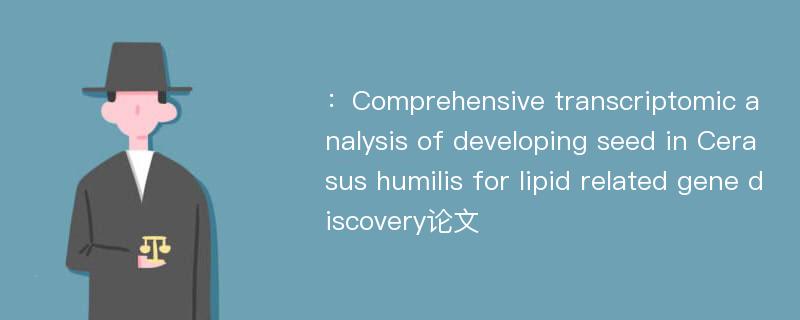
本文主要研究内容
作者(2019)在《Comprehensive transcriptomic analysis of developing seed in Cerasus humilis for lipid related gene discovery》一文中研究指出:Cerasus humilis is a woody shrub with increasing economic importance. Due to its high oil content in seed with desired fatty acid(FA) composition, C. humilis has been considered as a potential woody oilseed crop in China. However, FAs accumulation and related molecular mechanisms of FA biosynthesis in C. humilis seed have not been elucidated well. In this study, oil contents and FA compositions of developing C. humilis seed were analyzed. The total oil content in mature seed reached 48.7% while unsaturated FA concentration reached a high level of 96.2%. Three c DNA libraries of C. humilis developing seed were constructed at the beginning and 2 fast oil-accumulation stages, followed by Illumina sequencing with the platform of HiSeq~TM 2000. Differentially expressed unigenes(DEGs) were identified during the respective seed development stages to investigate transcription dynamics. Among DEGs, 82 unigenes were identified as being closely involved in de novo FA and triacylglycerol(TAG) biosynthesis. Surprisingly, among DEGs involved in TAG biosynthesis, expression of unigenes encoding GPATs(glycerol-3-phosphate acyltransferase) were relatively low and unigenes encoding LPAATs(lysophosphatidic acid acyltransferase) were highly expressed, suggesting that LPAAT contributed more in storage lipids metabolism in C. humilis seed. Genes encoding DGAT2(diacylgycerol acyltransferase2) were the most highly expressed while expression of DGAT1 was very low, suggesting DGAT2 was the dominant DGAT which catalyzed TAG biosynthesis. To verify these results,10 unigenes were selected and their expression patterns were analyzed by quantitative RTPCR. These data provided comprehensive information for understanding the molecular mechanism of FA and TAG biosynthesis in C. humilis seed.
Abstract
Cerasus humilis is a woody shrub with increasing economic importance. Due to its high oil content in seed with desired fatty acid(FA) composition, C. humilis has been considered as a potential woody oilseed crop in China. However, FAs accumulation and related molecular mechanisms of FA biosynthesis in C. humilis seed have not been elucidated well. In this study, oil contents and FA compositions of developing C. humilis seed were analyzed. The total oil content in mature seed reached 48.7% while unsaturated FA concentration reached a high level of 96.2%. Three c DNA libraries of C. humilis developing seed were constructed at the beginning and 2 fast oil-accumulation stages, followed by Illumina sequencing with the platform of HiSeq~TM 2000. Differentially expressed unigenes(DEGs) were identified during the respective seed development stages to investigate transcription dynamics. Among DEGs, 82 unigenes were identified as being closely involved in de novo FA and triacylglycerol(TAG) biosynthesis. Surprisingly, among DEGs involved in TAG biosynthesis, expression of unigenes encoding GPATs(glycerol-3-phosphate acyltransferase) were relatively low and unigenes encoding LPAATs(lysophosphatidic acid acyltransferase) were highly expressed, suggesting that LPAAT contributed more in storage lipids metabolism in C. humilis seed. Genes encoding DGAT2(diacylgycerol acyltransferase2) were the most highly expressed while expression of DGAT1 was very low, suggesting DGAT2 was the dominant DGAT which catalyzed TAG biosynthesis. To verify these results,10 unigenes were selected and their expression patterns were analyzed by quantitative RTPCR. These data provided comprehensive information for understanding the molecular mechanism of FA and TAG biosynthesis in C. humilis seed.
论文参考文献
论文详细介绍
论文作者分别是来自Oil Crop Science的,发表于刊物Oil Crop Science2019年03期论文,是一篇关于,Oil Crop Science2019年03期论文的文章。本文可供学术参考使用,各位学者可以免费参考阅读下载,文章观点不代表本站观点,资料来自Oil Crop Science2019年03期论文网站,若本站收录的文献无意侵犯了您的著作版权,请联系我们删除。
